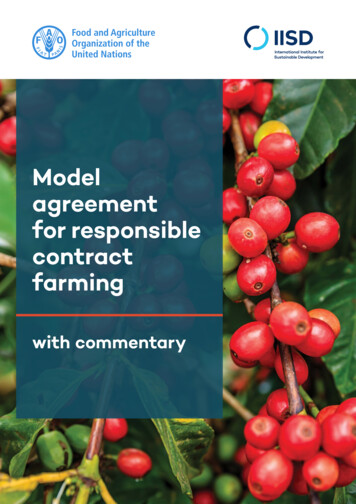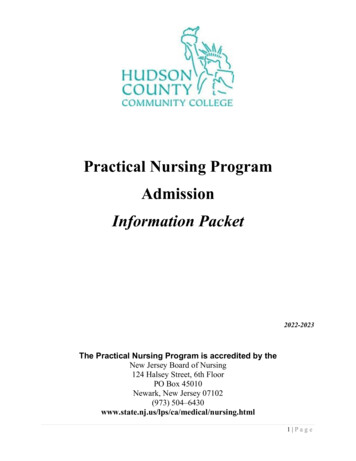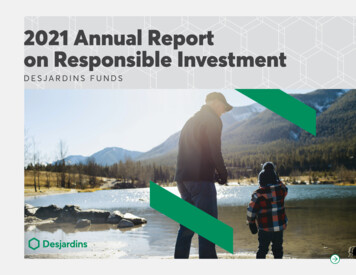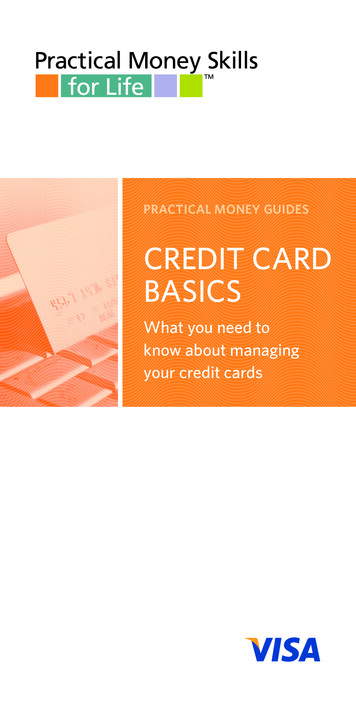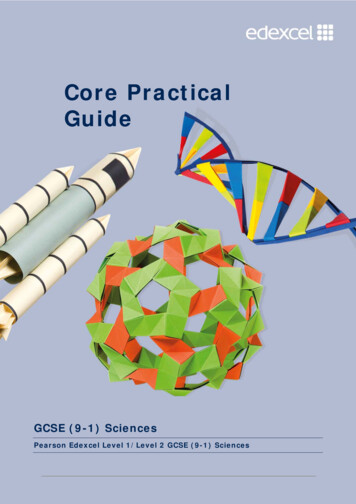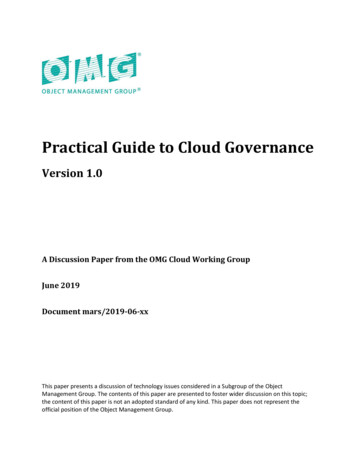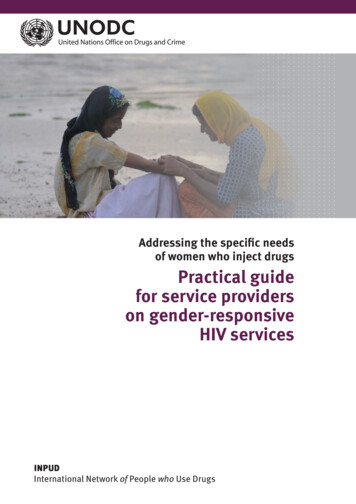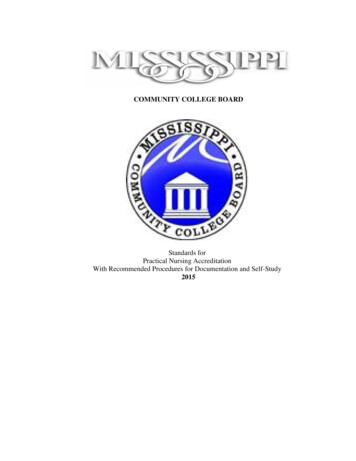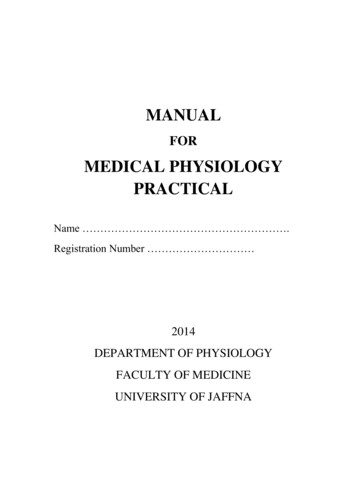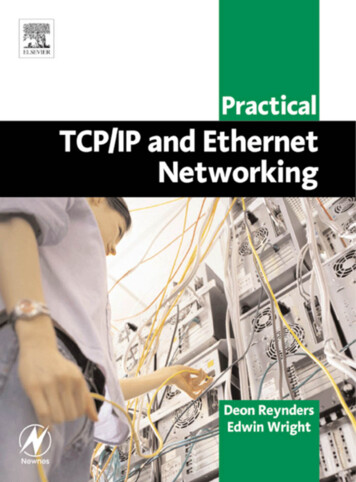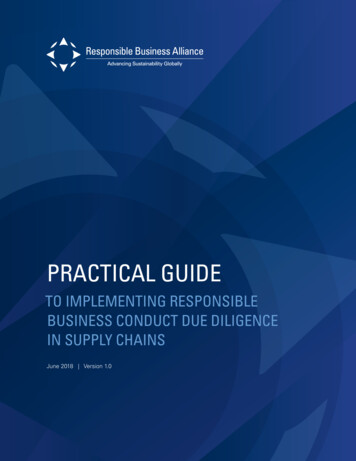
Transcription
PRACTICAL GUIDETO IMPLEMENTING RESPONSIBLEBUSINESS CONDUCT DUE DILIGENCEIN SUPPLY CHAINSJune 2018 Version 1.0
I. SUMMARYThere is a growing expectation for companies to respect human rights, labor rights, theenvironment and business ethics in their operations and throughout their supply chains.These expectations are reflected in international frameworks on responsible businessconduct as well as national legislation to address serious harms such as forced labor.Customers, businesses, investors and the general public are also demanding thatcompanies take steps to prevent adverse impacts and mitigate harms linked to theirbusiness operations and supply chains.The Responsible Business Alliance (RBA) helps member companies drive meaningfulchange in responsible business conduct and supply chain due diligence across tiers ofsupply chains in different sectors. RBA membership1 reflects the complexity, breadthand power of integrated supply chains, including companies in industry sectors suchas electronics, retail, auto and toys.Supply chains are extremely complex. Most companies have hundreds of customersand suppliers and suppliers typically provide services to more than one industry sector.While policy makers have taken steps to try to harmonize standards, the proliferation offrameworks and regulations related to supply chain due diligence results in a dauntingchallenge for many companies. There is an urgent need for clarity on how companiescan operationalize international recommendations and regulations into their supplychains and meet national and international expectations on responsible businessconduct.This RBA Practical Guide to Implementing Responsible Business Conduct DueDiligence in Supply Chains (Practical Guide) provides an overview of the major standardson responsible business conduct and demonstrates how RBA tools, best practices,initiatives and services can help2 companies operationalize and live into internationalsupply chain due diligence expectations.This Practical Guide is a “living document,” which will be periodically updated to reflectevolving responsible business expectations, stakeholder and member feedback,emerging best practices, new leg islative requirements, and revised RBA tools andprograms.1As of May 2018, the RBA has more than 120 member companies with combined annual revenue of over 5 trillion,directly employing more than 6 million people. More than 3.5 million people from over 120 countries contribute to themanufacture of RBA members’ products.2RBA tools and programs are meant to complement and enhance company due diligence actions and can drive maximumleverage by using common, harmonized approaches across sectors.
II. MAKING SENSE OF INTERNATIONALFRAMEWORKS AND DRIVERS OFRESPONSIBLE BUSINESS CONDUCTInternational frameworks such as the UN Guiding Principleson Business and Human Rights (UNGPs), the ILO Declarationon Fundamental Principles and Rights at Work and the ILOTri-Partite Declaration of Principles Concerning MultinationalEnterprises and Social Policy (together, the ILO Declarations),and the OECD Guidelines for Multinational Enterprises(OECD MNE Guidelines) provide high-level principles on whatis expected of companies in terms of responsible businessconduct. These standards crystalize expectations oncompanies’ responsibility to identify risks3, prevent, address,mitigate actual and potential adverse impacts in their supplychains and, where appropriate, provide some form of remedy.In addition to these international standards, a number ofcountries4 have enacted or are in the process of enactinglegislation to further promote and drive business uptake ofresponsible business conduct.Across all of these standards and frameworks, supply chaindue diligence is recommended as the process by whichcompanies can identify, prevent, address and/or mitigateadverse impacts in their supply chains. This concept ofsupply chain due diligence is further elaborated in the recentlyreleased OECD Due Diligence Guidance for ResponsibleBusiness Conduct (OECD RBC Guidance)5, which providesan overarching framework for supply chain due diligencethat aims to help companies understand and implement duediligence recommendations into their operations, supply3Risks are the likelihood of adverse impacts on people, theenvironment and society that enterprises cause, contribute or arelinked to.4See Annex for examples and descriptions of various existing andpending national legislation on reporting, due diligence, modernslavery and conflict minerals.5The OECD has also published due diligence guidances for specificsectors and supply chains, namely: minerals; agriculture; garmentand footwear; extractives; and finance. These sector guidancesprovide more detail and context for companies in specific supplychains. The OECD Due Diligence Guidance for Responsible SupplyChains of Minerals from Conflict-Affected and High-Risk Areas(OECD Minerals Guidance) is an example, and is used by RMI inthe development of RLI tools and services for members. See http://mneguidelines.oecd.org/duediligence/chains and other business relationships.The RBA, through its tools, programs and initiatives, helpsits members operationalize and implement the OECD RBCGuidance as well as other international recommendationson responsible business conduct into their operationsand supply chains. By using RBA tools, members candemonstrate that they are part of the growing movementof responsible businesses taking the necessary steps toprevent and address adverse impacts in their supply chains.PUBLIC PROCUREMENT IS A GROWINGDRIVER OF RESPONSIBLE BUSINESSCONDUCTPublic procurement accounts for a substantialproportion of taxpayers’ money in OECD and partnercountries, representing on average 12% of GDPand 29% of the national budget6. In recent years, aconsiderable shift has taken place from a purely costapproach to public procurement, to an approachthat includes environmental and social impacts.While in the past value for money meant the lowestprice, governments are increasingly concerned withthe broader impacts of the goods and servicesthey purchase. Many RBA members are potentialsuppliers to governments and must meet national andinternational standards to win and keep governmentbusiness. Potential government suppliers will needto demonstrate that they understand what leadingsupply chain due diligence entails, demonstrate howthey are implementing due diligence in their businessoperations and report on their actions to prevent,address, mitigate and, where relevant, remediate, themost salient human rights, labor rights, environmentaland business ethics risks in their supply chains.6OECD (2017), Government at a Glance 2017, OECD Publishing,Paris3
InvesemrExprDecnstotioatmedsst oanOrganisation forEconomic Co-operationand DevelopmentCuOECD MNEGuidelinesInternationalLabour OrganizationUN GuidingPrinciplesILODeclarations*Supply ChainDue DiligencegunReorAclattioInitiatives, Programs and ToolsResponsibleBusinessConductqunyyReir ementsCompa*ILO Declaration on Fundamental Principles and Rights at Work, ILO Tri-Partite Declaration of Principles Concerning Multinational Enterprises and Social Policy4
III. THE OECD DUE DILIGENCE GUIDANCEFOR RESPONSIBLE BUSINESS CONDUCTDUE DILIGENCE PROCESS AND SUPPORTING MEASURESThe OECD Due Diligence Guidance for Responsible Business Conduct (OECD RBC Guidance) takes the high-level principlesembodied in international standards7 and proposes a framework of six core processes to support supply chain due diligence.DUE DILIGENCE PROCESS AND SUPPORTING MEASURESIDENTIFY & ASSESSADVERSE IMPACTSCOMMUNICATEin operations, supply chains& business relationshipshow impactsare addressedEMBED RESPONSIBLEBUSINESS CONDUCTinto policies &management systemsTRACKimplementationand resultsPROVIDE FOROR COOPERATEin remediationwhen appropriateCEASE, PREVENTOR MITIGATEadverse impactsSource: OECD (2018)Due Diligence Process and Supporting MeasurThe framework helps companies “identify, prevent, mitigate and account for how they address actual and potential adverseimpacts in their own operations, their supply chain and other business relationships.”8 For more detail, RBA membersshould refer to the OECD RBC Guidance text.7The OECD RBC Guidance is aligned with the UNGPs. Per UNGP 17, “ business enterprises should carry out human rights due diligence. Theprocess should include assessing actual and potential human rights impacts, integrating and acting upon the findings, tracking responses, andcommunicating how impacts are addressed”.8OECD (2018), OECD Due Diligence Guidance for Responsible Business Conduct, ce-forresponsible-business-conduct.htm5
IV. HOW RBA TOOLS, PROGRAMS AND SERVICESCAN HELP MEMBERS OPERATIONALIZE SUPPLYCHAIN DUE DILIGENCE(USING THE OECD RBC GUIDANCE)RBA standards and tools provide a harmonized platformfor members to embed due diligence into their supplychain operations. The RBA Code of Conduct establishesstandards to ensure that working conditions in supplychains are safe, that workers are treated with respect anddignity, and that business operations are environmentallyresponsible and conducted ethically. The RBA Code is theDNA that underpins all RBA tools and programs.diligence. There are numerous RBA tools that have beendeveloped to help members implement supply chain duediligence into their operations.RBA tools are developed with input from membercompanies and updated on a regular basis to reflect thelatest recommendations and regulations on responsiblebusiness conduct. The table below provides greater detailon each RBA tool and how these help members meet thesupply chain due diligence recommendations.The RBA also provides a platform for dialogue withstakeholders to support members in their supply chain dueOperationalizing supply chain due diligence using RBA tools, programs and servicesOECD RBC GUIDANCESUB AREASRBA TOOLS, PROGRAMS AND SERVICESCORE PROCESS 1 Devise, adopt anddisseminate policies onRBC issues that articulatethe company’s commitmentto due diligence principlesand standards as containedin the OECD MNEGuidelinesRBA standards provide a harmonized platform for members to embeddue diligence policies into company management systems. The RBAalso actively engages with stakeholders to provide members withup-to-date information on emerging supply chain risks and regulations,which they can incorporate into company policies and managementsystems. Embed company RBCpolicies into companyoversight bodies andmanagement systems aspart of regular businessprocesses The RBA Code of Conduct. Members are expected to support theCode and actively pursue conformance to it. The Code is in alignmentwith the UNGPs, the ILO Declaration on Fundamental Principles andRights at Work and the UN Universal Declaration of Human Rights.Embed responsiblebusiness conductinto policies andmanagementsystems Incorporate RBC policiesand expectations intosupplier and businessrelationshipsRBA tools to support core process 1 include: The RBA Code outlines the necessary standards RBA membersmust establish in their supply chain operations to ensure they do notinfringe on workers’ rights, the well-being of their communities, theenvironment and business ethics in global supply chains. The Code also outlines necessary management systems9 to ensuremembers do not infringe on workers’ rights or the wellbeing of theircommunities. The Code is reviewed every three years to ensure itsrelevance to international norms and issues in global supply chains. 96RBA Compliance in Supplier Contracts: RBA best practice is tointegrate the RBA Code into supplier contracts to embed responsiblebusiness expectations into the business relationship.Management systems must be designed to ensure compliance withapplicable laws, regulations and customer requirements related tothe members’ operations and products as well as conformance withthe RBA Code of Conduct.
CORE PROCESS 2Identify and assessactual and potentialadverse impactsassociated withthe enterprise’soperations, productsor services Carry out broad /initialscoping exercise to identifywhere RBC risks aremost likely to be presentand which are the mostsignificantThe RBA has developed a number of tools to support members inidentifying and assessing actual and potential responsible businessconduct risks in the supply chain (core process 2). These tools includerisk assessment tools at a high-level as well as detailed analysis thatrequires more custom information from members. Conduct iterative andincreasingly in-depthassessments on themost significant risk areasidentified The RBA Sensing Survey is an online survey tool that helps membersidentify key risks in the aggregated supply chain for the industries RBArepresents. This information can support members as they conducttheir own supply chain assessments. Asses companyinvolvement in the actual orpotential adverse impact todetermine the appropriateresponses (Did theenterprise cause, contributeor is directly linked to thenegative impact?) Prioritize most significantrisks and impacts for action,address less significantimpacts over timeHigh-level, initial risk scoping tools include: The Corporate Self-Assessment Questionnaire (Corporate SAQ) isa tool designed to help members identify social, environmental andethical risks in their own supply chains and provides a high-levelunderstanding of risks in members’ areas of operation. The Facility Self-Assessment Questionnaire (Facility SAQ) helpsmembers obtain a detailed understanding of their own facilities andsupply chain risks to assess risk management systems and identifygaps. Members are strongly encouraged to use this tool with suppliersto assess risks in their suppliers’ facilities. Indirect Spend Tool. RBA offers members access to selfassessment questionnaires and audit protocols that can be applied tomembers’ indirect supply chain suppliers such as call center providers,security guard services, landscapers, and facilities managementproviders. RBA Online is a sustainability data management system that containssupply chain risk and performance data. With the consent of theparties involved, this data can accelerate the identification of risks toget a better picture of a business’ supply chain network.RBA in-depth risk assessment tools include: The Proprietary Risk Assessment Tool provides global risk indicesaligned to the RBA’s Code of Conduct. This in-house tool compilesdata from audits, the self-assessment questionnaires, as well asexternal risk information from respected sources such as the U.S.Trafficking in Persons (TIP) report, the World Bank Rule of Lawdata, and Freedom House List data. Members add in additional dataregarding their supplier business relationships including criticality ofsupplier (% of spend with supplier, sole source option, etc.), and riskelements of the supplier business model. This type of data is typicallyproprietary information to members and their suppliers. The toolcompiles these strands of data and derives a composite risk score thatprovides a first-level analysis to map suppliers against sector peers. Inherent Risk Profile tool: This tool includes information on asupplier’s inherent risk, including geographic location, product orservice provided, spend level from customer, and exclusivity ofproduct. The system can also integrate management proficiency datafrom the SAQs and audit scores. The tool combines this data to givemembers a composite risk level score per supplier. The Validated Assessment Process (VAP): The VAP is the RBA’sleading standard for onsite compliance verification and effective,shareable assessments. Through the severity rating system a VAPindicates a priority in which to address the issues identified in theaudit. The VAP can be used to conduct iterative and increasinglyin-depth assessments of suppliers. A complete VAP process, includingthe Corrective Action Plan (CAP) component, is a way to monitorongoing implementation through the two-year VAP cycle that wouldtake place under core process 4. The RBA Audit Cooperation Program (ACP) allows members tonominate their suppliers for a VAP audit. Suppliers nominated bymultiple members will be approached by RBA staff to conducta VAP. This use of industry leverage is in line with internationalrecommendations.Specific tools have been developed to identify and assess risks related toconflict minerals and forced labor. More detail on the specific tools relatedto these risks can be found in Section VI (Case Studies) of this document.7
CORE PROCESS 3Cease, prevent andmitigate adverseimpacts Stop activities that causeor contribute to adverseimpacts on RBC issues,develop and implementa plan that prevents andmitigates future/potentialadverse impacts Develop a plan to preventor mitigate actual orpotential adverse impactsdirectly linked to companyoperations, products orservices by a businessrelationshipDisengagement from suppliers is recommended as a last resort wherethe adverse impact is irremediable and there is no prospect of change.The RBA helps members develop plans that are fit for purpose toprevent and mitigate potential and actual adverse impacts. However,action and accountability rests with members themselves.RBA tools and services to support members implement core process3 include: The Corrective Action Plan (CAP) is a critical part of the ValidatedAssessment Process (VAP) (see above). The CAP is what enablesmembers to address and mitigate the adverse impacts found intheir own supply chains at the facility level. The CAP can be appliedto an entire facility and shared with multiple customers10. A CAPfor Priority Non-Conformances is required and reviewed by anindependent fourth party for appropriate and clear actions which, ifcorrectly implemented, would meet the requirements of a third-partyauditor. Supplier Training: RBA provides training and support in specificsectors and on specific issues. Training is developed in modulesand is available online. Currently, the RBA e-Learning Academy hasnearly 70 online training modules on a range of sustainability topicsincluding on how to prevent and mitigate adverse impacts. Collaboration. The RBA supports collaboration among interestedmembers to help drive action in parts of the supplier chain wheremembers are linked via a business relationship.Collaboration to mitigate risks related to conflict minerals and forcedlabor are addressed via specific RBA initiatives. More detail onmitigation actions related to these risks can be found in Section VI (CaseStudies) of this document.10CORE PROCESS 4Trackimplementation andresults Track implementationand effectiveness of duediligence activities Use lessons learned toimprove processes in thefutureThe facility owns the audit report and the CAP and chooses who toshare it with.The RBA encourages members to track their due diligenceimplementation actions and effectiveness, and apply lessonslearned to improve due diligence over time. Reflecting bestpractice, members are encouraged to have due diligence actionsassessed by third parties.RBA tools to support core process 4 include: The Corrective Action Plan (CAP), which is part of theValidated Assessment Process (VAP) provides for re-audits inremediation of non-conformance. The Priority Closure component of the ValidatedAssessment Process (VAP) promotes on-site complianceverification. On-site compliance verification carried out on RBAmember facilities and their suppliers’ facilities are completedby independent, third-party auditors specially trained in socialand environmental auditing and the VAP protocol. RBA Online includes supply chain performance datawhich, with consent of the parties involved, can track theeffectiveness of supply chain due diligence actions. An Audit Quality Manager (AQM) shadows the auditprogram and reviews auditors to promote continued learningand improvement among auditors.Specific tools have been developed to track due diligence actionsrelated to conflict minerals and forced labor. More information canbe found in Section VI (Case Studies) of this document.8
CORE PROCESS 5Communicatehow impacts areaddressed Communicate externallyrelevant information ondue diligence policies,processes , activitiesconducted to identify andaddress actual or potentialadverse impacts, includingthe findings and outcomesof those activitiesCommunicating relevant due diligence information externally can bechallenging for many companies. The RBA provides tools to supportreporting requirements as well as informational workshops on thelatest reporting requirements expected of companies.RBA tools and services to support core process 5 include: RBA Online Data Monitor, which allows members to generatestandard and custom supply chain reports to support companyspecific reporting requirements and publication of information. The RBA Annual Report, which provides industry-level informationon collective programs, activities, and findings, can be used bymembers for comparison to their own annual reports and toprovide benchmarks for improvement over time. Member Compliance Kits list out the types of publiccommitments, risk assessments and audits RBA membersare expected to carry out in their supply chains. These stepsare examples which members can cite in reporting andcommunicating on their due diligence actions related to modernslavery/forced labor for the U.K. Modern Slavery Act (UKMSA),California Transparency in Supply Chains Act (CATISCA) and U.S.Federal Acquisition Regulation (FAR).CORE PROCESS 6Provide for orcooperate inremediation whenappropriate When the companyidentifies that it has causedor contributed to actualadverse impacts, addresssuch impacts by providingfor or cooperating in theirremediation When appropriate, providefor or cooperate withlegitimate remediationmechanisms through whichimpacted stakeholders andrights holders can raisecomplaints and seek tohave them addressed withthe company The RBA regularly reviews the risk landscape in responsiblebusiness conduct and highlights specific issues that requiredeeper support and specific action, including for exampleremediation. The RBA routinely engages with stakeholders and expertson issues that may require remediation to understandexpectations around remediation and explore appropriateactions. The RBA also provides support by organizing members (whererequested) to coordinate action (while respecting antitrustregulations) where there are findings of adverse impacts,working collectively to help address them.More information of the RBA’s support to members on forcedlabor and conflict minerals can be found in Section VI (CaseStudies).THE RBA: A PLATFORM TO IMPROVESUPPLY CHAIN DUE DILIGENCEThe RBA also provides a platform for members toexchange perspectives and ideas on supply chainimplementation, improve their knowledge on a range ofsupply chain issues and develop solutions that are fit forpurpose. Examples of the RBA knowledge facilitationinclude: On-Demand Factory Lead training: Through theRBA e-Learning Academy a package of courses,with a test for each, is offered to those responsiblefor implementing the RBA Code of Conduct at thefactory level. The package walks participants throughall elements of the Code, critical CSR regulations, theaudit process and general management of a factorywith the voice of the worker in mind Auditor training: The RBA offers trainings for auditorsand corporate audit program managers. The trainingsare run by internationally recognized experts at multiday, in-person trainings that take place several timesper year Member networking: The RBA encourages membersto share best practices and help establish new industrywide solutions. The RBA encourages problem-solvingand finding shared solutions via meetings, such asthe RBA Leadership Circle, an annual forum for seniorleaders in member and non-member companies, todevelop possible solutions to common problems. TheRBA also hosts an Annual Conference focused oncorporate social responsibility in the global electronicssupply chain, with speakers from industry, civil societyand government and hosts 4-6 outreach meetings allover the world each year.9
V. RBA STAKEHOLDER ENGAGEMENT TOPROMOTE SUPPLY CHAIN DUE DILIGENCEStakeholder engagement is a critical part of due diligenceand is highlighted as one of the essential characteristics11 ofdue diligence in the OECD RBC Guidance. It can be vital indefusing high-risk situations and in developing solutions thatare constructive and effective.RBA-led stakeholder engagement provides members with anadditional platform for constructive dialogue with stakeholderson due diligence challenges and solutions. While the RBA cannotand would not speak for individual companies, it harnesses thevoice of its membership, encourages constructive dialogueand builds meaningful stakeholder engagement with a widerange of stakeholders.With regard to the core processes of supply chain due diligence,the RBA’s stakeholder engagement efforts help members: Catalogue responsible business conduct standards, issuesand regulations (core process 1) Complete data gaps in supply chain risk identification (coreprocess 2) Develop long-term, credible solutions by incorporatingstakeholder feedback into mitigation actions (core process 3) Engage with stakeholders on expectations of effectivedue diligence and ways to improve the due diligenceprocess (core process 4)The RBA engages with government officials, publicprocurement authorities, intergovernmental organizations, andother stakeholders on a regular basis to help raise awareness Develop best-in-class reporting for specific risks, forof RBA initiatives and tools, highlight industry action on keyexample the Responsible Minerals Initiative’s (RMI)issues, and promote greater harmonization across pendingcollaboration with the Global Reporting Initiative (GRI) onnew policy requirements. The RBA also solicits stakeholders’a reporting tool (core process 5)views so that this can feed into RBA tool development andinitiatives. Through its stakeholder engagement, the RBA can Understand and explore appropriate remediation actionsact as a conduit for companies to raise problematic issues within collaboration with stakeholders (core process 6)stakeholders in a candid and constructive way.1110See OECD RBC Guidance “Characteristics of due diligence –the essentials: Due diligence is informed by engagement withstakeholders, p. 18 and OECD RBC Guidance Annex, questions 8 to11, pertaining to stakeholder engagement for more information.
VI. RBA INITIATIVES TO PROMOTE SUPPLYCHAIN DUE DILIGENCE – CASE STUDIESThe RBA regularly reviews the risk landscape in responsiblebusiness conduct and highlights specific issues that requiredeeper support from the RBA. Based on member input andthe RBA’s engagement with stakeholders, the RBA canlaunch specialized initiatives around specific issues to helpmembers address these risks and find solutions to complexproblems. The Responsible Minerals Initiative (RMI) andthe Responsible Labor Initiative (RLI) are examples ofRBA-led initiatives on salient human rights risks in supplychains.Initiative members gain detailed knowledge on specificsupply chain risks, as well as access to customized toolsand services to collectively and individually address salienthuman rights risks, meet their responsible business conductcommitments and engage with specific stakeholdercommunities.RESPONSIBLE MINERALS INITIATIVE (RMI)IntroductionMore than 360 companies from over 10 industries participatein the Responsible Minerals Initiative (RMI)12 to supportresponsible sourcing of minerals globally. Founded in 2008,the RMI serves as a collaborative, multi-industry platformthat encourages and improves regulatory compliance andcompany due diligence through the development and broadapplication of tools, resources and guidance documents inthe minerals supply chain. The RMI is the largest industrysupply chain program focused on responsible mineralsupply chains. The majority of the RMI’s members aredownstream companies from a range of industries.The RMI was originally set up to assist RBA members inresponding to concerns raised by NGOs about ‘conflictminerals’ originating in the Democratic Republic of theCongo (DRC) and entering the global supply chains of theelectronics industry. When the United States enacted Dodd-12Frank Section 1502 in 2010, the RMI’s focus evolved to alsosupport industry compliance with the U.S. Dodd-Frank Act.The U.S. Securities and Exchange Commission (SEC)’sConflict Minerals Rule, which implements the conflictminerals provisions of Dodd-Frank, references the OECDDue Diligence Guidance for Responsible Mineral SupplyChains from Conflict-Affected and High Risk Areas (OECDMinerals Guidance) as one of the frameworks available tosupport due diligence. The RMI has since evolved to alsosupport company compliance with the European UnionRegulation on Conflict Minerals, which will go into effectin 2021. For more details on national regulations please seethe Annex of this document.THE RMI AND THE OECDMINERALS GUIDANCEThe RMI uses the five-step framework of the OECDDue Diligence Guidance for Responsible SupplyChains of Minerals from Conflict-Affected and HighRisk Areas (OECD Minerals Guidance) as its referenceguide. The OECD Minerals Guidance is aligned withthe OECD RBC Guidance and draws on the sameprinciples and core processes such as establishingmanagement systems, identifying and assessingrisks, mitigating impacts, conducting audits andreporting. While the OECD RBC Guidance is a generalframework applicable to companies from any sector,the OECD Minerals Guidance provides greater detailto companies in the minerals supply chain; in particularthose operating, sourcing or linked to minerals fromconflict-affected and high-risk areas. The OECDMinerals Guidance is referenced in the U.S. DoddFrank Act as one of the frameworks companies canuse to support supply chain due diligence.T
due diligence policies into company management systems. The RBA also actively engages with stakeholders to provide members with up-to-date information on emerging supply chain risks and regulations, which they can incorporate into company policies and management systems. RBA tools to support core process 1 include: The RBA Code of Conduct.
